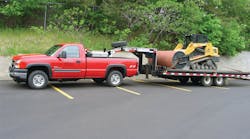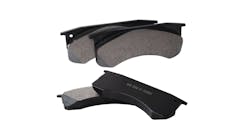Although choosing a trailer may seem straightforward, there are a multitude of considerations. A good starting point is to decide upon the type of trailer you require for your application and what you want from the trailer.
In order to get the most ROI, in addition to looking at rated payload capacity, consider versatility, trailer size and type, quality of construction, size of the cargo to be transported, how the cargo will be loaded and unloaded and brake configurations. There is also the matter of options, which includes ramps, flooring, siderails, tailgates, tie-downs, winches and spare tires.
Safe towing means not exceeding the trailer's gross vehicle weight rating (GVWR). This is noted on a label or placard - often referred to as the certification or VIN (Vehicle Identification Number) label. This label is typically mounted on the left (road) front side of the trailer, normally near the floor line or the coupler. The label also has the trailer's serial number, its unloaded gross vehicle weight and a gross axle weight rating (GAWR) - the weight a single axle can carry - for each axle on the trailer with its respective tire option.
If the trailer has a GVWR of 10,000 pounds or less, it will also have a tire label located in the same location as the certification label. The tire label provides recommended tire size and tire inflation pressure.
HITCHES
Another area of focus is choosing a trailer hitch - the device that attaches directly to a tow vehicle providing the connection between the tow vehicle and the trailer. Keep in mind a hitch system is only as strong as its lowest-rated component.
The trailer towing industry has developed a classification system that differentiates hitches according to the amount of weight they can tow. The system also addresses tongue weight and total weight.
The tongue is the part of the trailer which extends forward from the trailer and includes the coupler. The tongue weight of the trailer is the downward force exerted on the hitch of the tow vehicle by the trailer coupler.
Because a trailer acts like a lever and the axle of the trailer is its fulcrum, too little tongue weight can cause the trailer to sway. Too much tongue weight can result in not enough weight on the front wheels of the tow vehicle, making it less responsive to steering. Both conditions can create potentially dangerous situations.
The consensus is that the ideal tongue weight for typical applications falls in the range of 10 to 15 percent of the of the gross trailer weight - the weight of the trailer fully loaded in its actual towing condition.
The three most common types of hitches are the weight-carrying hitch, weight-distributing (or load equalizer) hitch and fifth wheel, or gooseneck, hitch:
- Weight-carrying hitches are designed to carry all of the weight of the trailer on the tongue weight.
- Weight-distributing hitches are used with a receiver hitch and special components that distribute the tongue weight among all tow vehicle and trailer axles. These units are better able to handle heavier trailers and are less prone to sway problems.
- Fifth wheel hitches are designed for mounting the trailer connection point in the middle of the truck bed using either a fifth wheel and a pin on the trailer or a ball to engage a coupler on the trailer.
BRAKING SYSTEMS
The selection of a braking system is dependent upon the tow vehicle, type of trailer and its fully loaded weight. For a trailer with a loaded weight that exceeds 1,500 pounds, many states require a separate braking system and a breakaway switch located on the tongue of the trailer to activate the trailer brakes in the event the trailer becomes disconnected from the tow vehicle to stop the runaway trailer.
Some states require braking systems on all axles of the trailer. Check your state's requirement by contacting the motor vehicle administration.
There are two basic types of trailer braking systems: electronically-controlled and surge.
Electronically-controlled brakes provide automatic and manual control for trailer brakes by way of a brake control unit mounted in the tow vehicle within reach of the driver. This type of braking system connects the brake system on the tow vehicle to the brake system on the trailer. The controller senses the braking force of the tow vehicle and in turn activates the brakes on the trailer.
A surge brake is an independent, self-contained hydraulic braking system on the trailer that uses the trailer's natural momentum to actuate the brakes. Activated by a master cylinder at the junction of the hitch and trailer tongue, surge brakes are automatically applied when the tow vehicle decelerates.
The forward motion of the trailer compresses the mechanism, transferring high-pressure brake fluid to the trailer wheel brake cylinders to apply the trailer brakes. The more the tow vehicle slows down, the more pressure on the trailer brakes.
CONSTRUCTION
How a trailer is built goes far in determining how long it will last and whether it's appropriate for your specific needs. A trailer that is overbuilt will result in more trailer than needed. Conversely, one that is underbuilt and lacks the structural integrity necessary to do the job will have more downtime and repair costs. Make sure the frame is sturdy enough for the cargo to be hauled.
Trailers made from aluminum are lighter and allow for more payload capacity. Aluminum trailers tend to withstand rust and corrosion better than steel trailers.
The smoother the suspension, the better it protects the trailer, the cargo and the tow vehicle from excessive shock, and the more comfortable the ride. Suspensions come in two basic varieties: leaf spring and torsion. Leaf springs are the traditional suspension systems.
Torsion suspensions provide a better ride than leaf springs as they cushion bumps and rough spots better and with less bouncing. Unlike leaf springs which are connected to each other by an axle, torsion suspensions work independently so road impacts on one side of the trailer are not transferred to the other.
As with any piece of equipment, trailers must be serviced so maintenance features that enhance serviceability should be yet another consideration.
Also give some thought to selecting a trailer manufacturer/dealer to do business with. A knowledgeable, experienced manufacturer/dealer that can help match the trailer to your hauling needs and requirements goes a long way toward your benefits.
LOADS
Trailer safety extends beyond having the appropriate trailer for the application. Weight distribution on a trailer is critical to safe performance because the ability of a driver to handle and control the tow vehicle and trailer is greatly improved when the cargo is properly loaded and distributed. The cargo weight should be balanced from side to side and distributed evenly along the length of the trailer.
Additionally, towing stability depends on keeping the center of gravity as low as possible. Load heavy items as close to the axle positions as reasonable and do not exceed the GAWR. All items being transported need to be properly secured and braced to prevent them from moving during travel.




